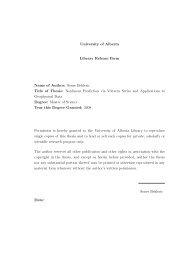Regularization of the AVO inverse problem by means of a ...
Regularization of the AVO inverse problem by means of a ...
Regularization of the AVO inverse problem by means of a ...
Create successful ePaper yourself
Turn your PDF publications into a flip-book with our unique Google optimized e-Paper software.
CHAPTER 1. INTRODUCTION 2<br />
may show different anomalies on seismic section such as bright-spot, flat-spot and dim-spot<br />
(McQuillin et al., 1984). ’Bright-spot’ appears where rocks-filled with gas and results in an<br />
increased contrast i.e. it is associated with strong amplitude contrast across lithology and<br />
<strong>the</strong>ir fluid content. On <strong>the</strong> contrary, ’dim-spots’ are associated with weak amplitude and<br />
’flat-spot’ occur at fairly sharp gas-liquid contact. These anomalies on <strong>the</strong> seismic section<br />
can be used as direct indicators <strong>of</strong> hydrocarbon. However, such anomalies can exist due to<br />
o<strong>the</strong>r structural changes; for example local buildups <strong>of</strong> carbonate (old oyster reefs) (Taner<br />
et al., 1979). This indicates that detailed information about <strong>the</strong> physical properties <strong>of</strong> <strong>the</strong><br />
rocks that causes <strong>the</strong> amplitude anomaly should be estimated. Those physical properties<br />
help to predict fluid content (oil, gas, or water) and avoid <strong>the</strong> ambiguity in <strong>the</strong> interpre-<br />
tation <strong>of</strong> <strong>the</strong> amplitude anomalies. In o<strong>the</strong>r words, <strong>the</strong>y give additional information about<br />
potential reservoirs or help to identify new hydrocarbon reservoirs. However, extracting<br />
<strong>the</strong> physical model parameters from seismic data is not a simple task. It involves extensive<br />
ma<strong>the</strong>matical modeling and algorithms for seismic data inversion. In <strong>the</strong> next two sections,<br />
I will discuss about forward and <strong>inverse</strong> <strong>problem</strong>s.<br />
1.1 Forward Problems<br />
The method to derive information about a given system from known physical parameters is<br />
what is called forward (direct) <strong>problem</strong>. The concern in this kind <strong>of</strong> <strong>problem</strong> is describing<br />
a behavior <strong>of</strong> a given system in terms <strong>of</strong> <strong>the</strong> measured parameters i.e. constructing <strong>the</strong><br />
physics <strong>of</strong> <strong>the</strong> <strong>problem</strong>. It is an easy <strong>problem</strong> if <strong>the</strong> physical model is known. A simplified<br />
diagram which shows a relationship between <strong>the</strong> model and <strong>the</strong> data in forward modeling<br />
is shown in Figure 1.1.<br />
1.2 Inverse Problems<br />
Inverse <strong>problem</strong>s are <strong>problem</strong>s which arises when data measurements are obtained and one<br />
wants to estimate unobservable property. In o<strong>the</strong>r words, it is a method <strong>of</strong> inferring model<br />
parameters that characterize a system under study (see Figure 1.1). Inverse <strong>problem</strong>s are<br />
common in applied sciences such as geophysical exploration, medical tomography, remote<br />
sensing, and astronomy. The basic step in formulating <strong>inverse</strong> <strong>problem</strong>s is to write down a<br />
system <strong>of</strong> equations (linear or non-linear) that fully describe <strong>the</strong> relationship between <strong>the</strong><br />
observed data, <strong>the</strong> physics model, and <strong>the</strong> unknown model parameters. Depending on <strong>the</strong><br />
number <strong>of</strong> equations and <strong>the</strong> unknown model parameters, <strong>the</strong> system <strong>of</strong> equations can be<br />
classified as underdetermined, even-determined or overdetermined. For certain defined num-<br />
ber <strong>of</strong> equations and unknowns, <strong>the</strong> <strong>problem</strong> is said to be overdetermined if <strong>the</strong> system <strong>of</strong>









